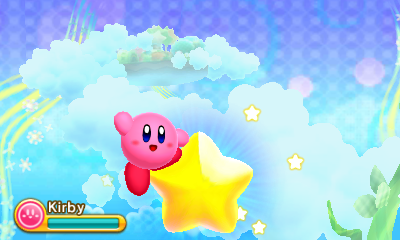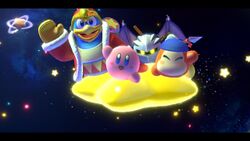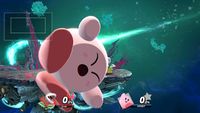Fourth wall

The term fourth wall is used to describe the separation of the audience from a performance. It is originally derived from stage play, where an imaginary fourth wall is said to separate the audience from the characters being portrayed, though it need not be a literal wall. This wall is meant to exist in the context of the story, which means that if actors look beyond the wall at the audience, whether intentionally or not, they are said to be 'breaking the fourth wall', thus breaking the illusion of a self-contained story. This can be pushed further by having actors directly address or interact with the audience, which is usually done for comedic effect or satire. Another means of breaking the fourth wall includes having the actors acknowledge their status as fictional characters, interacting with a narrator, or tampering with stage elements not meant to be interacted with such as backgrounds, cameras, or in the case of video games, the user interface. Breaking the fourth wall is particularly common in children's media, often as a method to engage the children with the characters in question.
Examples in the Kirby series
The Kirby series breaks the fourth wall on many occasions, though it is important to distinguish the difference between interactions in menus and instruction manuals and those in actual gameplay. The former cases are understood to take place outside of the context of the proper story, and as such are not canon. (For example, a menu screen that tells the player to "Press Start" is not considered breaking the fourth wall.) This article will only focus on examples of the fourth wall being broken in gameplay or in-game cut-scenes.
General

One common way that video games in general will break the fourth wall is to treat the display screen as a physical barrier within the game, or at least as a camera. The Kirby series does this on several occasions by flinging its characters into the "screen" for a more dramatic defeat. In such cases, the screen is often assumed to be a glass window.
In many games in the series, Kirby will wave at or otherwise acknowledge the player during certain moments. The first example of this is the ending of Kirby's Dream Land, where Kirby hoists up a sign in the very last cut-scene saying 'bye-bye'. This tradition carries on through most games in the series, with the ending of Kirby Star Allies having Kirby and any of his present friends waving at the player as they fly away.
In several games, particularly later ones, symbolic objects such as Doors and goal doors are directly interacted with as objects in the environment. This is particularly prevalent in Kirby: Triple Deluxe and Kirby: Planet Robobot. Enemies such as Mirras and Nidoos can even take on the appearance of these symbolic objects, blurring the line between gameplay and story functionality.
Kirby's Dream Land
While the game is paused, Kirby will start dancing in place if left alone for long enough. This example is particularly notable as nothing is meant to move during a pause session.
Kirby Air Ride
While Kirby is riding an Air Ride Machine, he will acknowledge the player in a number of different ways. When left to coast forward for an extended period of time, Kirby will look back and motion for the player to make an input. When performing a smooth landing after a glide, Kirby will turn and pose ecstatically.
Template:KCC KPP
In the intro cut-scene, the opening narration specifically states that the Magical Paintbrush is transported to the player's hands (as another way to describe the Nintendo DS stylus).[1]
Kirby's Dream Collection Special Edition
Magolor directly addresses the player at the beginning of the New Challenge Stages, explaining the game's backstory and following up on [[Kirby's Return to Dream Land|Template:KRtDL KAW]]. He refers to the player as a separate entity from Kirby, but does not otherwise break the established continuity of the games.
Kirby: Triple Deluxe
In this title, it is possible for Kirby to be knocked into and splat against the fourth wall directly whenever hit by a large object moving in toward the player.
Some bosses are able to interact with the screen in a way that it hinders the player's view, with Paintra (covering the screen with paint) and Pyribbit (burning the screen to cover it with ash) being the most prominent examples.
On two separate occasions, when Kirby uses the Hypernova ability to defeat Flowery Woods and Queen Sectonia, their Stamina bars are ripped from the user interface and fly into Kirby's mouth.
- TDX Kirby Splat.png
Screenshot from Kirby: Triple Deluxe where Kirby splats against "the Nintendo 3DS screen"
- Paintra Screen Paint.jpg
Paintra's paint stripes block the player's view
Hypernova Kirby tastes some delicious health bars
Dedede's Drum Dash Deluxe
Breaking the fourth wall is actually used as a hazard in this game; in a few stages, there are obstacles called "blindfold banners", which temporarily cover part of the screen. As they would have no impact on King Dedede within the setting of the game, they exist purely to hinder the player. They primarily appear in stage four, "Bouncing Boss Battle", carried by Bronto Burts. In the "C-R-O-W-N-E-D: Reprise" stage, Magolor appears with a blindfold banner in one segment, directly facing the player and laughing if King Dedede falls into a pit.
Kirby: Planet Robobot
This game continues the gimmick from Triple Deluxe where Kirby can be knocked into the screen by certain obstacles. When he is piloting the Robobot Armor, he will leave a temporary crack in the screen when he hits. It's possible to make the Halberd slam into the screen and crack it during Star Dream's third phase, if it gets caught in both the "Install Hole" and "Fatal Error" attacks.
In President Haltmann's boss battle, he can also cover the screen in money bills, hindering the player's view.
During the Staff Credits for Story Mode and Meta Knightmare Returns, Kirby in the Robobot Armor or Meta Knight can interact with the credits text by punching them into the screen (for the former) or slashing them in two or into the screen (for the latter).
Kirby's Blowout Blast
During the staff credits, Kirby can sometimes be seen watching a piece of the credits text scroll by.
Kirby Star Allies
The Artist Copy Ability has a move in Kirby Star Allies named "Painbrush" that covers the entire screen in paint splats of assorted colTemplate:Ors.
Super Smash Bros. series
Starting with Super Smash Bros. Melee, the games in the Super Smash Bros. series allow fighters who are launched beyond the top blast zone to occasionally splat briefly against the screen in a process called a Screen KO. The exact mechanics of this process differ between each game.
References
- ↑ "Kirby touches the rainbow brush and... It transports to you on a ray of light!" - Narration from the opening cut-scene of [[Kirby: Canvas Curse|Template:KCC KPP]]

